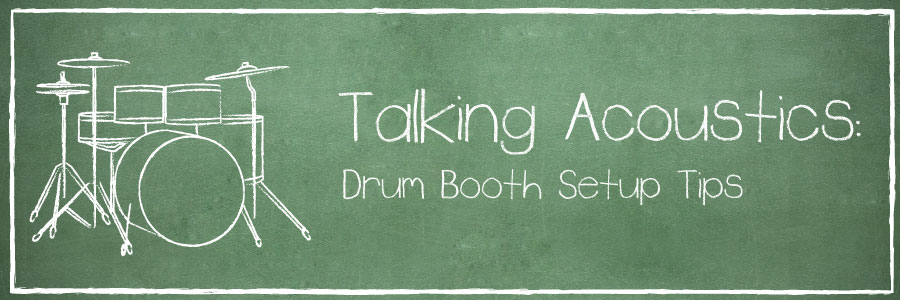Drum Booth Setup: Talking Acoustics
- Mar 2, 2017

Audimute’s “Talking Acoustics” video series offers you easy solutions for the noise in your life. Presented by our acoustic specialist, Rick, these videos aim to explain the complexities of sound in an easy to understand way.
In the first video, Drum Booth Setup, Rick discusses 4 inexpensive solutions for controlling drum room noise. Rick, a drummer himself, offers tips from personal experience, years of teaching drum lessons and his vast knowledge of acoustic science.
1. Decouple kit from floor
The first drum room setup tip is to decouple your drum kit from your floor. When your drum kit sits on the floor the sound waves shoot directly through the floor to the people below you. Creating a platform for your drums to sit on will reduce the amount and the intensity of sound that travels to the floor below.
To decouple your drum kit from the floor, take a piece of ply wood, wrap it in carpet padding and carpeting and set your kit up on top of that. This solution won’t reduce noise transfer however; it does make the situation much more livable for you and your neighbors.
For added sound reduction our Peacemaker®, noise barrier product, installed between two pieces of plywood and then wrapped in carpeting will reduce even more noise transfer to the people below you.
2. Set up kit to face room not wall
The second tip is to set your drum kit up so that the bass drum audience side is not facing any given wall. When your kit is too close to the wall the sound waves compress and then intensify in volume. It is best to set your kit up towards one side of the room and then face the audience side outward. This gives the sound time to travel and weaken before hitting the wall again.
3. Seal off air passage ways
The third drum booth setup tip is to seal off air passageways like doors, windows and vents. Air passage ways are vehicles for noise transfer because anywhere air can go sound can go so sealing passage ways is important.
-Start by sealing off the gaps around your doors with Door Seal Kit or weather stripping.
-If you have a vent in your practice space that projects your sound into other rooms, try creating a trap door for your vent with a piece of plywood. When you are done practicing simply remove the trap door.
-Finally create a window plug for any windows in your space. A window plug can be made by taking a piece of plywood and then adding a layer of our Peacemaker®, sound barrier product, to it and then placing it in your window.
4. Practice with Brushes
The last drum room setup tip is to practice with brushes. Brushes will do more then just bring the sound down in your practice space. Brushes allow you to develop more wrist strength because they do not have the natural rebound that sticks do forcing you to maintain better control of your hands.
For more helpful Drum Booth setup tips watch the video below or check out our Drum Room Soundproofing Guide. Tune in for the next Talking Acoustics video, 5 tips to control Dog Barking Noise.

